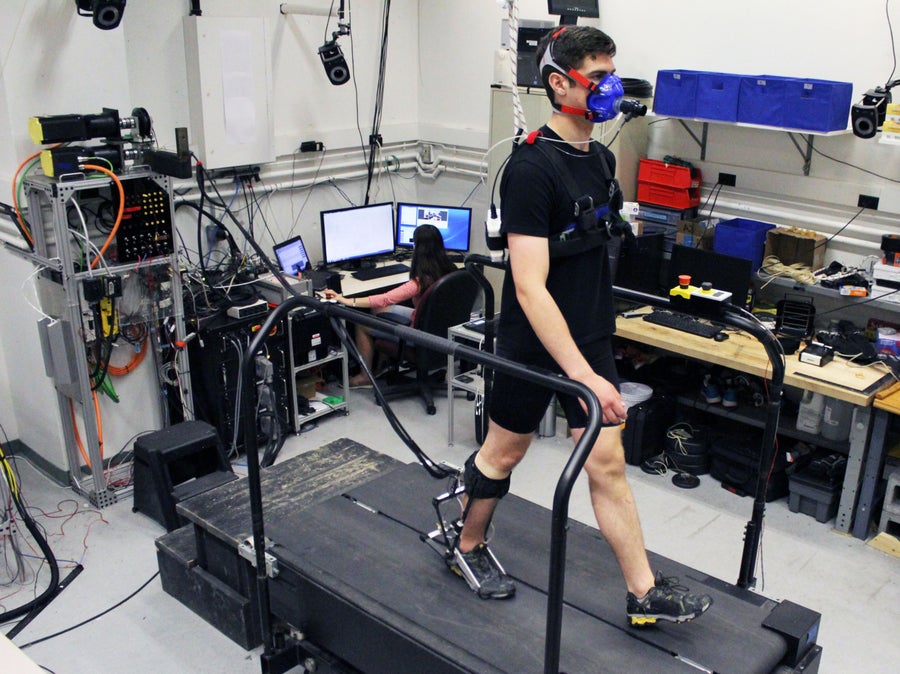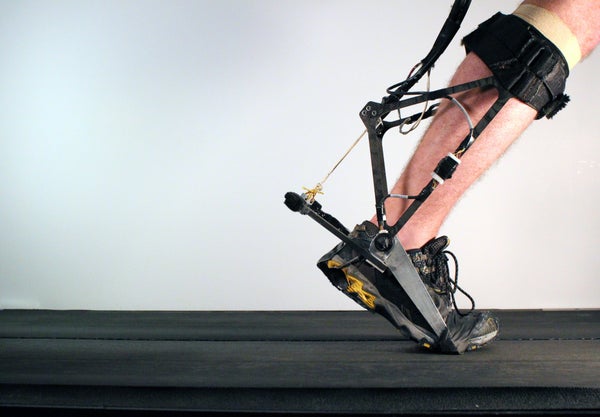The promise of robotic exoskeletons has long offered the hope that motorized suits could one day restore movement to the disabled or grant soldiers and workers superhuman strength. But despite decades of hype, the fabled “exosuit” remains largely the stuff of Iron Man and science fiction, with most real-life prototypes quietly flopping or struggling to find a market. But the concept refuses to fade. Instead, researchers at Carnegie Mellon University and elsewhere are rethinking the design process, literally from the ground up.
The Carnegie Mellon team is pursuing a new approach that improves endurance by lowering the wearer’s energy exertion—a long-standing challenge for the field. Rather than attempting to build a conventional full-body or even a lower-body augmentation suit, they created a software-controlled ankle brace with the straightforward goal of reducing the effort needed to walk, making the motion less exhausting for people with physical impairments. Such simple devices—targeted, low-profile, even soft—could finally sidestep previous pitfalls to deliver practical and affordable exoskeletons, the researchers reported in a study last month in Science.
The algorithm that controls any exoskeleton’s movements must be tuned to provide precisely the timing and power the wearer needs. In this case, Steve Collins, an associate professor of mechanical engineering at Carnegie Mellon and principal investigator on the study, wanted the exoskeleton to automatically figure out how to minimize the wearer’s energy consumption while walking.
On supporting science journalism
If you're enjoying this article, consider supporting our award-winning journalism by subscribing. By purchasing a subscription you are helping to ensure the future of impactful stories about the discoveries and ideas shaping our world today.
To test different assistance strategies, the team strapped each study participant into a spindly apparatus that applied exoskeleton-like torque to the ankle. Participants were also hooked up to a breath monitor to measure their oxygen consumption—and by proxy their energy use. Using an “evolutionary algorithm” that repeatedly tries several combinations of torque and timing and then selects the best for further tinkering, the researchers cut energy use by about 14 percent compared with walking without the brace. That is a substantial improvement over any previous system. But to Collins, the particulars and even the algorithm’s performance are beside the point. This is not “a paper about an exoskeleton,” he says. “This is a paper about a method for designing exoskeletons” that breaks with precedent in important ways.

A participant in the experiment walks on a treadmill wearing the exoskeleton simulator while a mask measures his oxygen consumption. Credit:Kirby Witte, Katie Poggensee, Pieter Fiers, Patrick Franks and Steve Collins
A More Organic Approach
Collins’ design approach is geared toward fixing the problems that have plagued previous efforts to develop exosuits. The best-known attempts are military prototypes that hewed closely to the science fiction vision of bestowing superhuman strength on the person wearing the contraption. Much fanfare accompanied the announcements of robotics company Raytheon Sarcos’s “XOS 2” military exosuit in 2010 and Lockheed Martin’s similar Human Universal Load Carrier (HULC) the following year. But moving a human takes a lot of power, and few soldiers want to drag around a huge battery pack. A full-body suit must also support its own weight, no mean feat for the 68-kilogram XOS 2. The XOS 2 was ultimately shelved due to a lack of funding from the U.S. Department of Defense, according to Sarcos. HULC was put on hold after it failed to perform adequately in the military’s tests.*
Medical exoskeletons, another oft-cited use for the technology, have fared only slightly better. Several dozen are currently on the market, but the companies that make them typically “liv[e] from grant to grant…hop[ing] to sell rehabilitation exoskeletons in onesies and twosies” to clinics, says Dan Kara, practice director for robotics at market research firm ABI Research. When it comes to suits that could help patients at home, Kat Steele, a University of Washington assistant professor of mechanical engineering, says, “I haven’t yet seen a strong example of the translation of…promising technology out into…things people can use in daily life.” Even when the technology is ready, cost remains a barrier. The military might be willing to shell out tens of thousands of dollars per suit, but that’s a tough sell for private citizens and their insurance companies.
According to Collins, though, the key challenge has been more fundamental than price or power: “We don’t know what [exoskeletons] should do to assist a user,” he explains. After all, human bodies are already pretty good at what they do. Past projects largely assumed what would be helpful and then “spen[t] years building…hypothesis-testing machines,” says Max Donelan, a professor of biomedical physiology and kinesiology at Simon Fraser University. Often the result was “a robot that you’re riding in,” hardly in need of a human operator, says Luke Mooney, co-founder of robotics firm Dephy. When the human does try to join in the motion, the two get in each other’s way, canceling out the gains for all but the most extreme disabilities.
Donelan advocates for a closer collaboration between human and machine, “improv[ing] upon what the body is already doing by doing things the body can’t.” That is what Collins’s approach is intended to do. It starts from a known pain point: Physiological analysis has shown that much of the energy consumption in walking comes from flexing the ankle, making that flexion a good target for assistance. The robotic brace’s task is thus not just some predefined form of ankle assistance but to work out the best way to be helpful—including when to stay out of the way.
Putting the User First
A similar user-focused mentality is gradually moving the field past other historical barriers to widespread adoption. For instance, many previous projects have disregarded usability to a surprising extent. Kara says the testers he interviewed complained of simple inconveniences—the machines “were difficult to don and doff. They were chafing; there was rubbing.” Additionally, Mooney says, no currently available exoskeletons can be unboxed, put on and used fluidly within a matter of minutes. That would entail not only the user quickly learning to use the device but the device adapting to the user. “Everyone is different,” Collins notes. “An assistance strategy that works really well for you may make walking harder for me.”
These issues, however, are also starting to fade with the advent of minimalist designs targeted for very specific user needs. To augment healthy runners, an exoskeleton might use small hip and ankle motors with algorithms like Collins’s that adapt to the user’s gait. And to help soldiers lift heavy ordnance, an exoskeleton might not even need power. Some promising designs are entirely passive, using springs to transfer weight directly to the ground or to store energy from bending over. Such exoskeletons are alreadymakinginroads in industries including construction and shipyard work.
Paraplegics might need a suit for the whole lower body, but perhaps one made with comfortable, clothlike materials such as the “soft exosuits” under development at the Harvard University lab of Conor Walsh, an associate professor of engineering and applied sciences. In a study published in Science Translational Medicine on Wednesday, Walsh and colleagues at Harvard and Boston University say they improved the mobility of stroke victims with the aid of a lightweight, low-profile soft robotic ankle support.
Still, not everyone has abandoned Hollywood’s idea of one suit to rule them all. The U.S. Special Operations Command (USSOCOM), for example, is still developing an augmentation exoskeleton known as the Tactical Assault Light Operator Suit (TALOS), which USSOCOM spokesperson Lt. Cmdr. Lara Bollinger says is on track for a 2018 prototype. Some academics are skeptical, but most seem willing to entertain “Iron Man suits” as a long-term possibility.
In the near future, though, the benefits will likely come from simpler, more targeted devices—and Collins thinks those benefits are not far off. “In the next five years,” he says, “it will be common to use or know someone who uses an exoskeleton regularly.” Not quite the exoskeletons we hoped for, but perhaps the exoskeletons we need.
*Editor’s Note (07/27/17): This sentence was edited after posting. It originally stated that both the XOS 2 and HULC were shelved after failing to perform adequately in the military’s tests.
